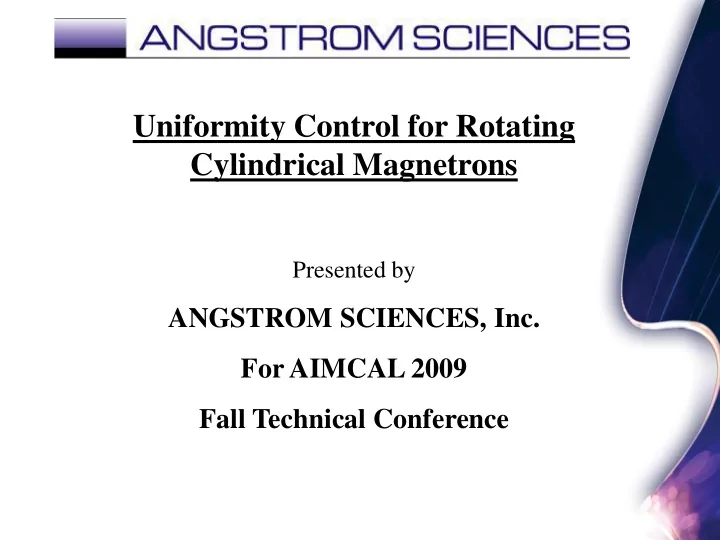

Uniformity Control for Rotating Cylindrical Magnetrons Presented by ANGSTROM SCIENCES, Inc. For AIMCAL 2009 Fall Technical Conference
Magnet Array Optimization for Rotating Cylindrical Magnetrons Uniformity Adjustment Using Spacers to resolve “tilt” Using Shunts to resolve “local” effects A Working Example Magnet Array Throughput Considerations Maximizing Target Utilization Maximizing “Throughput Efficiency”
Magnet Array Optimization for Rotating Cylindrical Magnetrons Uniformity Adjustment – Addressing “Tilt”: “ Tilt ” – Will be defined as a non-uniformity effect spanning a large distance (~1/2 meter). Adjustment means – Adjusting the relative distance between the magnet array and the target surface, at defined intervals, to counter the observed “Tilt”
Magnet Array Optimization for Rotating Cylindrical Magnetrons Uniformity Adjustment – Addressing “Tilt”: Addition of Spacers to Adjust Magnet Array to Target Surface Distance
Magnet Array Optimization for Rotating Cylindrical Magnetrons Uniformity Adjustment – Addressing “Tilt”: 2D Model (FEMM) of magnet array shows the effects on the magnetic field of inserting spacers. Spacers or mechanical adjustment is used to raise or lower the magnet array at specific locations
Magnet Array Optimization for Rotating Cylindrical Magnetrons Uniformity Adjustment – Addressing “Local” Effects: “ Local ” – Will be defined as a non-uniformity effect spanning a distance from ~ 2-40 cm. Adjustment means – Change the intensity of the magnetic field in the position directly aligned with the non-uniformity
Magnet Array Optimization for Rotating Cylindrical Magnetrons Uniformity Adjustment – Addressing “Local” Effects: Multiple Shunt Positions Adjustable along Magnet Array Length Magnetic Stainless Steel Shunts Vertical Shunt Adjustment
Uniformity Optimization for Rotating Cylindrical Magnetrons Uniformity Adjustment – Addressing “Local” Effects: To eliminate “local” uniformity effects, 1 or more shunts may be cut to length and used for tuning over the magnet array length Depending on the size of the uniformity anomaly, shunts may be used on one or both sides of the magnet array.
Uniformity Optimization for Rotating Cylindrical Magnetrons Uniformity Adjustment – A Working Example: Exercise: End user must achieve +/-2% film thickness uniformity on their cylindrical magnetrons System Assumptions: Anode conditions, gas flow and pumping throughput is constant and stable Process Conditions : Al Target – 60” Length Power Supply 25kW (DC) 10 RPM Target Rotation Process Gas 3mT Argon
Uniformity Optimization for Rotating Cylindrical Magnetrons Uniformity Adjustment – A Working Example:
Uniformity Optimization for Rotating Cylindrical Magnetrons Uniformity Adjustment – A Working Example: All magnet array adjustments are based on the basic correlation: Deposition Rate a Magnetic Field Strength Step #1: Establish a baseline uniformity from which we will begin to shape the magnet array in order to achieve film thickness uniformity.
Uniformity Optimization for Rotating Cylindrical Magnetrons Uniformity Adjustment – A Working Example: (+/- 7 %) The dashed red lines show we have 2 slopes over the entire length. Both towards the center of the magnet array. We will add spacers and retest!
Uniformity Optimization for Rotating Cylindrical Magnetrons Uniformity Adjustment – A Working Example: (+/- 7 %) Step #2: Remove “tilt” over a long length by adding/removing spacers along the length of the array.
Uniformity Optimization for Rotating Cylindrical Magnetrons Uniformity Adjustment – A Working Example: (+/- 4.5 %) At this point we can either try further adjustment to the tilt, or, try to remove the “local” non -uniformity
Uniformity Optimization for Rotating Cylindrical Magnetrons Uniformity Adjustment – A Working Example: (+/- 4.5 %) Step #3: Begin to focus on localized non- uniformities by use of shunts.
Uniformity Optimization for Rotating Cylindrical Magnetrons Uniformity Adjustment – A Working Example: (+/- 2.5 %) The addition of a single shunt brought the total uniformity in the correct direction but was not strong enough. Add 2 nd shunt to other side of magnet array!
Uniformity Optimization for Rotating Cylindrical Magnetrons Uniformity Adjustment – A Working Example: (< +/- 2.0 %) Uniformity Criteria is met!
Uniformity Optimization for Rotating Cylindrical Magnetrons Uniformity Adjustment – A Working Example: (< +/- 2.0 %) Applying the same procedures for a single 3.5m magnet array on a 3.2m Substrate
Magnet Array Optimization for Rotating Cylindrical Magnetrons Throughput Considerations – Target Utilization Maximize Your System Uptime and the Stability of the Sputtered Thin Film Uniformity Many magnet array designs induce End-Grooving Reduces target utilization Changes distance of magnet array to target surface, thus changing uniformity distribution
Magnet Array Optimization for Rotating Cylindrical Magnetrons Throughput Considerations – Target Utilization End Grooving refers to the target erosion at the racetrack turnarounds This effect causes a loss in target utilization and changing uniformity effects
Magnet Array Optimization for Rotating Cylindrical Magnetrons Throughput Considerations – Target Utilization No End-Grooving! Deepest Erosion is along the length of the target surface
Magnet Array Optimization for Rotating Cylindrical Magnetrons Throughput Considerations – Flux Distribution The angular separation, or distance between racetracks can effect throughput • Excessive amount of sputtered film ends up on shields – reducing rate • Excessive amount of film on shields leads to onset of debris and particulate contamination
Magnet Array Optimization for Rotating Cylindrical Magnetrons Throughput Considerations – Flux Distribution Substrate Chamber / Zone Planar Magnetron Shielding Flux Distribution The “normal” orientation of the material flux to the substrate helps to minimize the amount of debris migrating to the sputter shields
Magnet Array Optimization for Rotating Cylindrical Magnetrons Throughput Considerations – Flux Distribution Substrate Because the target surface is round, deposition is now “off - normal”. Chamber / Zone As the distance between Shielding racetracks increases, rate decreases and likelihood for debris increases Cylindrical Magnetron Cylindrical Magnetron Flux Distribution Look for minimum separation Flux Distribution or Flux Angle
Summary Summary 1. Rotatable Cylindrical Magnet Arrays can be tuned for thin film layers in uniformities of +/-2% or better • Look for ability to use spacers • Look for ability to use shims 2. Rotatable Cylindrical Magnet Arrays also have a large influence on uniformity stability and Rate or Throughput • Look for elimination of “End - Grooving” • Minimize the Angular Flux Between Racetracks
Recommend
More recommend